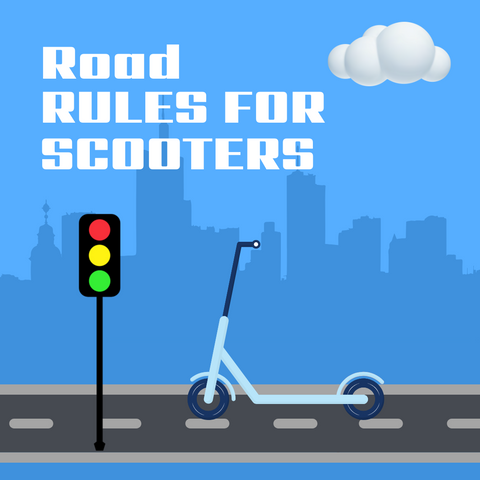Can You Ride a Scooter in the Rain?
Riding an electric scooter in the rain can be challenging and risky, especially if you're not prepared. This guide provides detailed information on whether you can ride a scooter in the rain, safety precautions, legal considerations, and best practices to ensure a safe and enjoyable ride.
Understanding Waterproof Ratings for Electric Scooters
Electric scooters are not inherently waterproof. Riding in heavy rain or through standing water can damage the mechanical and electronic components of your scooter. To understand how well your scooter can withstand rain, check its Ingress Protection (IP) rating, which indicates the level of protection against dust and water.

Decoding IP Ratings
- First Digit: Indicates protection against solid particles (e.g., dust). Ranges from 0 (no protection) to 6 (complete protection).
- Second Digit: Indicates protection against liquids (e.g., water). Ranges from 0 (no protection) to 9 (protection against high-pressure water jets).
For example, an IP66 rating means the scooter is completely protected against dust and can withstand high-pressure water jets from any direction.
Riding Safety Tips for Wet Weather
- Assess Weather Conditions: Always check the weather forecast before heading out. Avoid riding in heavy rain or storms.
- Wear Protective Gear: Always wear a helmet, and consider additional protective gear like waterproof jackets, pants, gloves, and elbow and knee pads.
- Adjust Riding Speed: Reduce your speed when riding in the rain to maintain better control and reduce the risk of slipping.
- Increase Visibility: Ensure your scooter’s headlights and taillights are operational. Wear reflective gear to increase visibility to other road users.
- Stick to Familiar Routes: Avoid unfamiliar routes. Stick to well-maintained roads and avoid puddles and slick surfaces.
- Avoid Abrupt Maneuvers: Be gentle with the throttle, brakes, and steering to prevent skidding and loss of control.
- Maintain Safe Distance: Keep a safe distance from other vehicles to allow more time for braking.
- Regular Inspections: Regularly check your scooter’s brakes, lights, and tires to ensure they are in good working condition.
Choosing the Right Tires
Pneumatic tires (air-filled) are recommended for riding in wet conditions due to their superior traction and shock absorption compared to solid tires. They help reduce the risk of slipping and provide a smoother ride on wet surfaces.
Reliable Electric Scooters for Rainy Conditions
Consider scooters with high IP ratings and water-resistant features. For example, the DRIDER10X and WideWheel PRO are excellent choices with their robust water-resistant capabilities.
DRIDER10X Features
- IPX54 rating
- LED headlights and taillights
- Front and rear shock absorption
- Dual hydraulic brakes
- ABS
- Independent suspension
- Pneumatic tires
DRIDER8 Features
- IPX66 rating
- Water protection fenders
- Silicone-sealed deck openings
- Front pneumatic tire, rear solid tire
Legal Considerations and Regulations
Riding an electric scooter in the rain is subject to local regulations. It's important to familiarize yourself with these regulations to ensure compliance and safety. For instance, some states may require electric scooters to have specific safety features or limit where they can be ridden during inclement weather. Always check with your local Department of Transportation for the latest guidelines.
For example, California's Department of Transportation provides comprehensive guidelines on electric scooter use, which can be accessed here.
Concerns and Issues with Water Exposure
- Electronics Malfunction: Water can cause short-circuiting, leading to malfunctioning of electronic components.
- Corrosion: Moisture can corrode metallic parts, reducing the scooter’s lifespan.
- Battery Damage: Water seepage can damage the battery, reducing its range and longevity.
- Brake Performance: Brakes are less responsive in wet conditions, requiring more distance to stop.
- Safety Risks: Slippery roads increase the risk of accidents and injuries.
To mitigate these risks, always follow the manufacturer’s guidelines on water exposure and perform regular inspections to identify any potential issues.
Frequently Asked Questions (FAQ)
1. Can you ride any electric scooter in the rain?
Not all electric scooters are designed for riding in the rain. Check the IP rating to determine the level of water resistance. High IP ratings indicate better protection against water.
2. What should I do if my scooter gets wet?
Dry your scooter thoroughly after exposure to water. Avoid riding through deep puddles and always perform a thorough inspection to ensure no water damage has occurred.
3. Are there scooters specifically designed for rainy conditions?
Yes, some scooters are designed with higher IP ratings and water-resistant features, making them suitable for riding in the rain. Examples include the DRIDER10X and WideWheel PRO.
4. What legal regulations should I be aware of?
Legal regulations vary by location. Always check with your local Department of Transportation for specific rules regarding riding electric scooters in the rain.
5. How can I stay safe while riding in the rain?
Wear protective gear, reduce your speed, increase visibility, and perform regular maintenance checks. Always be mindful of road conditions and avoid sudden maneuvers.


